To track blood oxygen with your smartwatch, verify it has SpO2 functionality, then wear it snugly 2-3 cm above your wrist bone. Remain completely still during 15-second measurements and establish a baseline by taking readings at consistent times. Normal readings range from 95-100%, while 90-94% warrants monitoring. Remember smartwatches have a 2-3% error margin compared to medical devices. The following guide reveals how to maximize accuracy and interpret your results effectively.
Understanding Blood Oxygen and Why It Matters
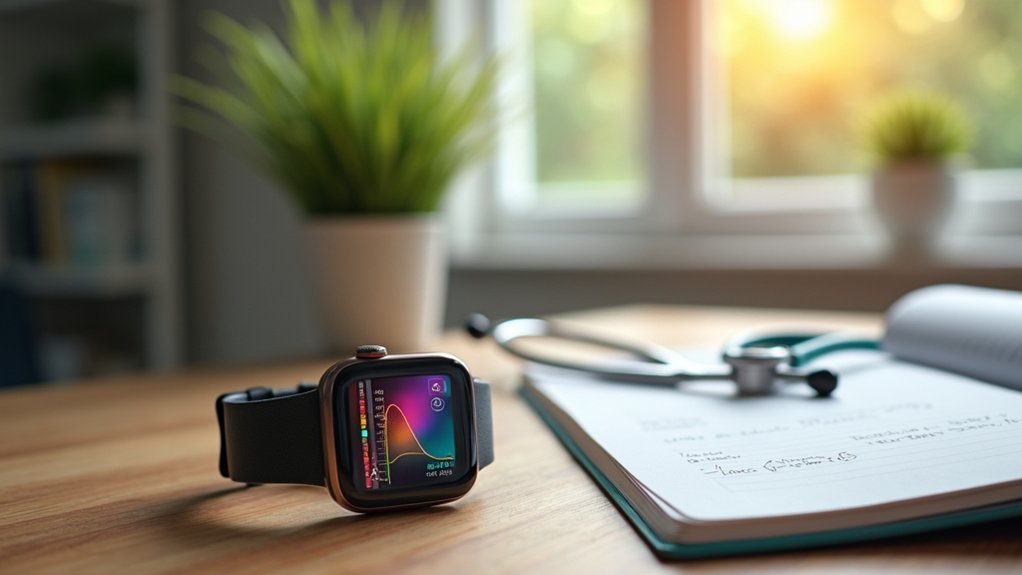
Oxygen—the invisible yet essential element that powers your entire body. When you breathe, this important gas travels from your lungs into your bloodstream, where red blood cells transport it to every cell in your body.
Without adequate oxygen, your cells can’t produce the energy needed for basic functions.
Your blood oxygen level, measured as SpO2, indicates how effectively your body distributes oxygen. Normal SpO2 readings typically range from 95% to 100% in healthy individuals. Healthy levels support ideal brain function, heart health, immune response, and even digestion.
When levels drop, you might experience impaired thinking, reduced physical performance, and stress on essential organs.
Monitoring your blood oxygen provides early warning of potential health issues and helps you maintain peak performance.
With smartwatches now offering SpO2 sensors, tracking this important health metric has become more accessible than ever.
How Smartwatch SpO2 Sensors Actually Work
Your smartwatch measures blood oxygen using light reflection technology that works right through your skin.
The device emits red and infrared light that bounces off your blood cells and returns to the watch’s optical sensors.
These sensors then detect how much oxygen your hemoglobin is carrying based on differences in light absorption between oxygenated and deoxygenated blood. This technology, known as photoplethysmography (PPG), is the fundamental principle behind how smartwatches monitor SpO2 levels.
SUBHEADING DISCUSSION POINTS
While most of us simply check the percentage on our screen, smartwatch blood oxygen monitoring relies on sophisticated optical technology to peek inside your bloodstream without ever breaking the skin.
Your smartwatch uses photoplethysmography (PPG) sensors that emit red and infrared light into your wrist, then analyze how much returns.
The science is clever: oxygenated blood absorbs more infrared light, while deoxygenated blood absorbs more red light. By measuring this ratio, your device calculates your SpO2 percentage.
Advanced algorithms filter out motion artifacts and ambient light interference to improve accuracy. These algorithms are especially important since sudden drops in blood oxygen levels can signal serious medical conditions that require immediate attention.
Though generally less precise than fingertip medical oximeters, some models like the Withings ScanWatch have achieved clinical validation.
Remember that most smartwatch SpO2 readings serve as wellness indicators rather than medical diagnostics.
Light Reflection Technology
Four key components power the SpO2 monitoring on your wrist: red light, infrared light, optical sensors, and advanced algorithms. These components work together through a method called reflectance mode, where lights shine through your skin and reflect back to sensors on the watch’s rear surface.
When you wear your smartwatch, it emits both red and infrared light into your wrist. Oxygenated blood absorbs infrared light while allowing red light to pass through. Conversely, deoxygenated blood absorbs red light while letting infrared light pass. Similar to heart rate monitors, the technology utilizes light and photodiodes to capture these subtle blood flow changes.
The optical sensors measure how much of each light type returns, and algorithms calculate your blood oxygen percentage based on these differences.
This technology enables continuous SpO2 monitoring throughout your day, providing valuable health data without requiring clinical visits.
Best Smartwatches for Blood Oxygen Monitoring in 2023
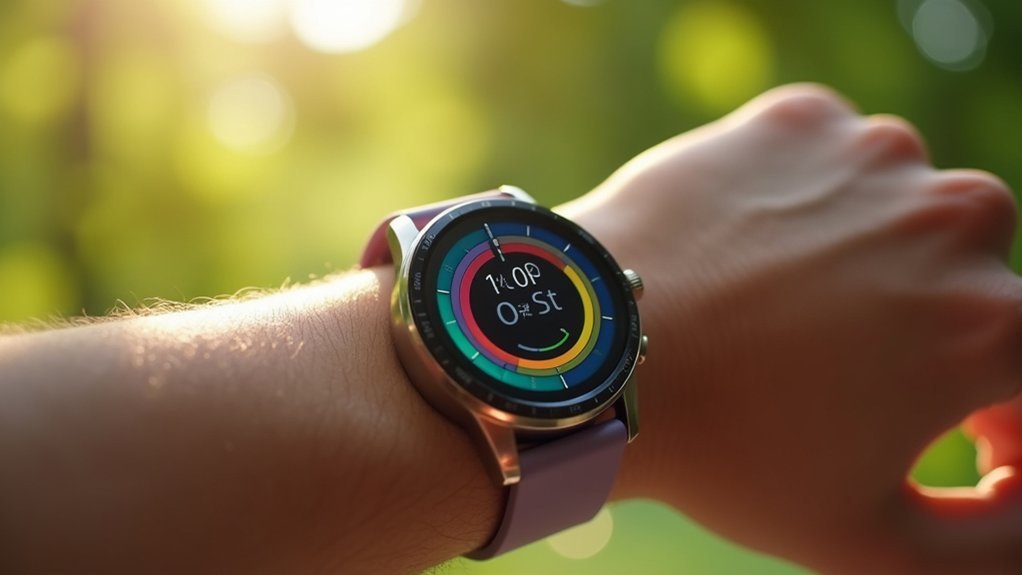
Several top-tier smartwatches have emerged as leaders in blood oxygen monitoring technology this year. The Apple Watch Series 7 stands out with 58.3% of its readings falling within clinical reference ranges, showing minimal deviation from medical-grade devices. Research indicates that the Apple Watch 8 demonstrates the highest reliability for detecting hypoxemia compared to other smartwatch models.
Blood oxygen monitoring has found its champion in the Apple Watch Series 7, delivering near-medical accuracy in a sleek wearable form.
For fitness enthusiasts, the Garmin Fenix 6 Pro delivers impressive accuracy with average SpO2 readings of 94.4%, closely matching clinical standards. The Garmin Venu 2s remains popular despite its tendency to underestimate readings.
If you’re seeking a simpler option, consider the Withings ScanWatch with its 78.5% overall accuracy.
When choosing your device, prioritize features like continuous monitoring, health app integration, and alert systems for abnormal readings. Remember that factors such as skin tone, movement, and environmental conditions can affect your smartwatch’s SpO2 accuracy.
Setting Up Your Device for Accurate SpO2 Readings
Your smartwatch’s band tightness directly impacts SpO2 reading accuracy, with a snug fit preventing ambient light interference while still maintaining comfort.
Position your device 2-3 centimeters above the wrist bone with the watch face pointing upward to guarantee proper sensor contact with your skin.
For consistent measurements, consider using sport bands which provide better stability during readings and replace worn bands that no longer maintain adequate contact with your skin.
Make sure to keep your arm steady for 15 seconds while the watch performs its blood oxygen measurement to ensure accurate results.
Optimal Band Tightness
Achieving accurate blood oxygen (SpO2) readings begins with proper band tightness on your smartwatch. Your watch should be snug enough to maintain constant skin contact without restricting blood flow or causing discomfort.
- Find the sweet spot – Position your watch one finger’s width above your wrist bone, tight enough to prevent movement but loose enough to allow a finger to slide underneath.
- Adjust for activities – Tighten slightly during workouts, loosen during rest periods.
- Check regularly – Band looseness changes throughout the day due to sweat and movement.
- Consider your band material – Flexible, breathable materials often allow better fit adjustment while maintaining comfort.
Remember that improper tightness is one of the most common causes of inaccurate SpO2 readings on smartwatches. Even with perfect positioning, understand that recent studies show consumer smartwatches have moderate correlation with medical-grade oximetry devices when measuring blood oxygen levels.
Placement Position Matters
The placement position of your smartwatch is a critical factor that can make or break SpO2 reading accuracy. Position your device just above the wrist bone where sensors can access better blood flow without bone interference. Avoid areas with excessive hair, scars, or tattoos that disrupt light transmission.
Keep your wrist still during measurements—movement creates artifacts that compromise results. For best readings, rest your arm on a stable surface while measuring. Remember that excessive movement can significantly interfere with sensor accuracy and lead to unreliable blood oxygen readings.
| Position Factor | Best Practice | Why It Matters |
|---|---|---|
| Location | Above wrist bone | Minimizes bone interference |
| Skin Contact | Firm, direct contact | Guarantees ideal light transmission |
| Movement | Keep completely still | Reduces motion artifacts |
| Timing | Measure at rest | Provides stable circulation |
| Consistency | Same spot each time | Reduces measurement variability |
Interpreting Your Blood Oxygen Data: Normal vs. Concerning Levels
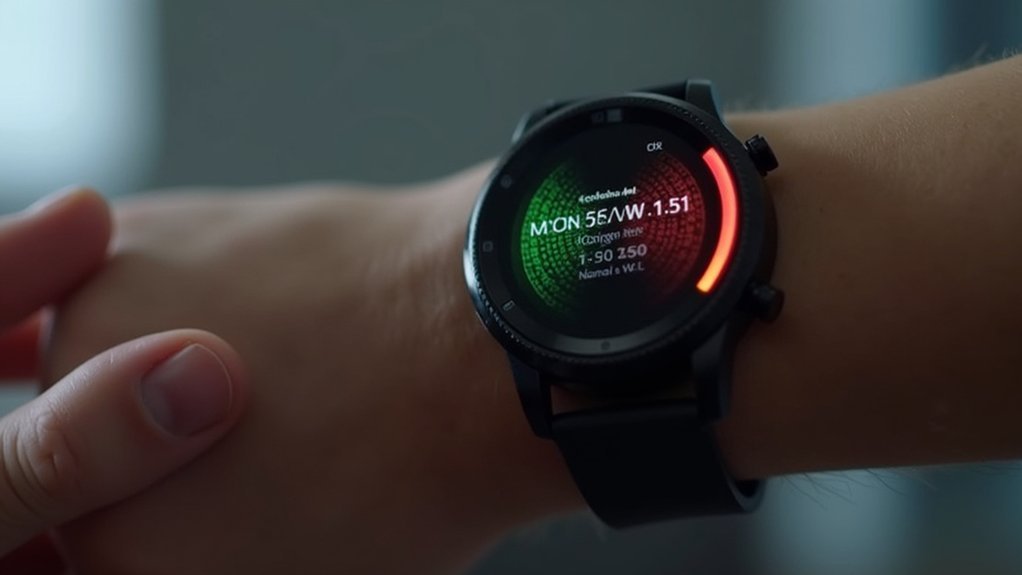
Understanding what your smartwatch’s blood oxygen readings actually mean can make the difference between peace of mind and unnecessary worry. While these devices provide valuable insights, knowing how to interpret the numbers is essential.
- 95-100%: This range indicates normal blood oxygen levels for most healthy individuals, suggesting your body is receiving sufficient oxygen.
- 90-94%: These readings fall below ideal levels and warrant monitoring; consider consulting your healthcare provider if this persists.
- Below 90%: This indicates hypoxemia and requires immediate medical attention, especially if accompanied by symptoms like shortness of breath or confusion. Remember that portable devices like smartwatches may have a 2-3% error margin compared to clinical blood gas tests.
- Fluctuating readings: Consider external factors like cold fingers, movement, or nail polish that might affect accuracy before assuming a health issue.
When to Trust (and When to Question) Your Smartwatch Readings
While smartwatches provide convenient access to blood oxygen data, knowing when to trust these readings and when to be skeptical can be challenging.
Trust readings from clinically validated devices with quality sensors, particularly when you’re at rest and readings remain consistent. Apple Watch Series 7, for example, demonstrates higher accuracy compared to many competitors.
Question readings if you have darker skin (due to potential bias in sensor technology), during excessive movement, at high altitudes, or if wearing nail polish. Although a recent study found no significant variation in accuracy across different Fitzpatrick skin tone groups, it’s still wise to be cautious.
Also be skeptical during rapid oxygen level changes or if you have chronic pulmonary disease.
For most reliable results, focus on trends rather than isolated readings, understand the context of measurements, and combine blood oxygen data with other health metrics.
In critical situations, always verify with clinical-grade devices.
Integrating Blood Oxygen Monitoring Into Your Health Routine
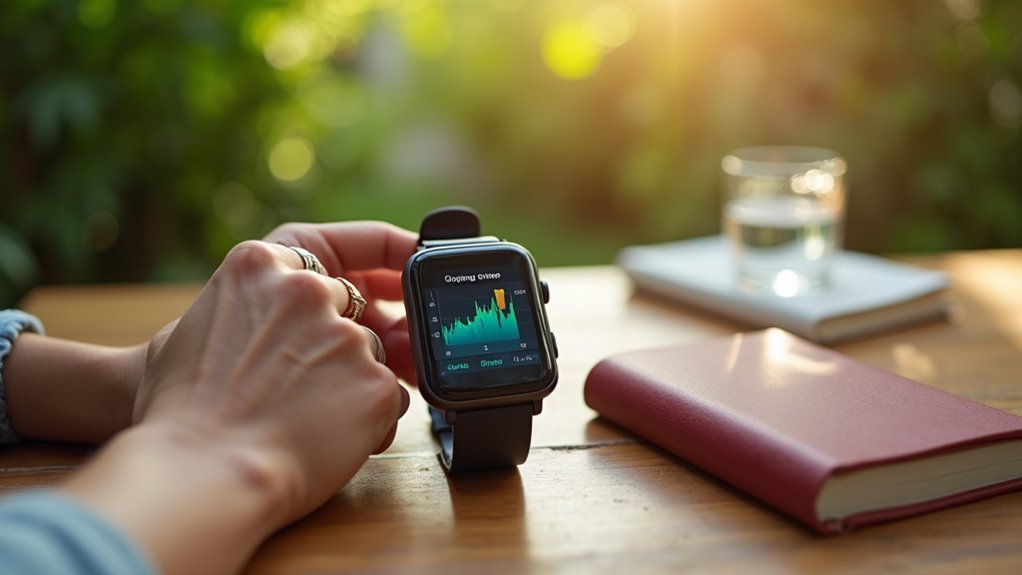
Now that you know when to trust your smartwatch’s blood oxygen readings, you can meaningfully incorporate this feature into your daily health monitoring.
Adding SpO2 tracking to your routine provides insight into your body’s oxygen delivery system, complementing other crucial signs your device measures.
Monitoring blood oxygen levels offers a window into respiratory function that enhances your comprehensive health picture.
- Establish a baseline by taking readings at consistent times daily for several weeks when you’re feeling healthy.
- Track alongside activities like sleep, exercise, and meditation to identify patterns affecting your oxygen levels.
- Set up notifications for significant deviations from your normal range that might warrant attention.
- Share collected data with healthcare providers during checkups to enhance discussions about your respiratory and cardiovascular health.
Remember that normal pulse oximeter readings typically range from 95% to 100% on healthy individuals, which gives you a reference point for your smartwatch measurements.
This proactive approach transforms your smartwatch from a gadget into a valuable health management tool.
Frequently Asked Questions
Can Blood Oxygen Readings Be Affected by Altitude?
Yes, your blood oxygen readings will be affected by altitude. As you climb higher, there’s less atmospheric pressure, reducing available oxygen. Your smartwatch will show lower but normal readings at elevation compared to sea level.
Do Caffeine or Alcohol Consumption Impact Spo2 Readings?
Caffeine rarely impacts your SpO2 readings directly, despite affecting blood flow. Alcohol doesn’t typically alter readings on smartwatches either, though both substances can influence how oxygen is delivered throughout your body.
How Often Should I Calibrate My Smartwatch’s Spo2 Sensor?
You don’t need to manually calibrate your smartwatch’s SpO2 sensor. These devices are designed to operate continuously without user intervention, as calibration is handled automatically by the watch’s internal software.
Are Spo2 Readings Accurate During Exercise?
SpO2 readings during exercise are less accurate due to movement interference and increased pulse rates. You’ll get better results when stationary. For exercise monitoring, consider these readings as estimates rather than precise measurements.
Can Spo2 Monitoring Drain My Smartwatch Battery Faster?
Yes, SpO2 monitoring will drain your smartwatch battery faster, especially in continuous mode. You’ll notice more significant drain than with manual checks. Consider using scheduled or periodic monitoring to balance health tracking with battery life.
In Summary
Blood oxygen monitoring with your smartwatch is a valuable tool, but it’s not a medical replacement. You’ll get the most benefit by tracking trends over time rather than fixating on single readings. Remember to keep your device properly calibrated, wear it correctly, and share your data with healthcare providers when needed. It’s just one piece of your overall health puzzle—use it wisely.

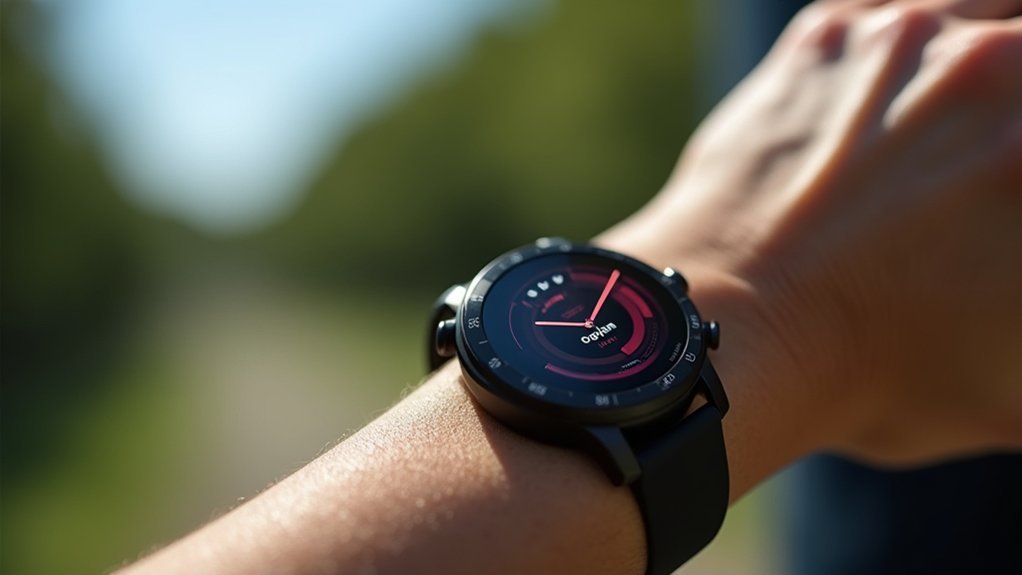



Leave a Reply